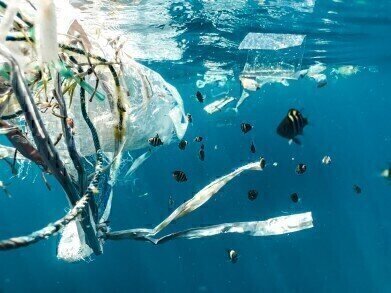Hazardous Waste
Are You Eating Plastic?
Mar 31 2015
Many people have heard about the massive blanket of plastic in the middle of the Pacific Ocean — the Great Pacific Garbage Patch — with media reports talking about a giant vortex of plastic in the Pacific Ocean. Whilst this is not quite the truth, the reality of plastic in our oceans is disturbing. Recent research has attempted to quantify the amount of plastic entering the oceans annually. The findings make for unpleasant readings — especially if you like fish suppers.
Pacific garbage patch
The term garbage patch might bring images of large areas of ocean covered in plastic. The National Oceanic and Atmospheric Administration (NOAA) in the United States gives an insight into what is actually in the Pacific, and other oceans. Whilst there are areas where plastic is concentrated due to natural wind and ocean currents, there is no ‘landfill’ on the ocean’s surface.
Much of the plastic contamination is due to small pieces of plastic — much of it microscopic — suspended in the water column. New uses of plastics make the task of keeping the environment clean tougher. This article by the NOAA, The Search for Microplastics: From Face Scrubs to the Sea, highlights the damage micro beads from face scrubs can do to the environment — just so we can look beautiful.
How much plastic is in our cceans?
A recent study has looked at how much plastic enters the ‘water system’, and where it comes from. In a report in Science, ‘Plastic waste inputs from land into the ocean’, a team from the University of Georgia have calculated how much plastic is entering the oceans. In a press release from the University of Georgia, a co-author of the paper, said ‘For the first time, we’re estimating the amount of plastic that enters the oceans in a given year.’ This is the first time this exercise has been carried out on such a scale, and the numbers are frightening.
They looked at all the plastic entering the oceans from land and sea, developing models for each source. They estimate that between 4.8 and 12.7 million tons of plastic entered the ocean in 2010 from people living within 50 kilometres of the coast in 192 countries.
Eating plastic?
But researchers are finding significantly lower quantities floating on the ocean’s surface, suggesting the majority will be found in the water column and on the bottom of the oceans. What happens to this material could affect fish-eaters everywhere.
Evidence shows that fish, and other marine animals, contain plastic residues and these could have an impact on humans as we are the next step in the food chain. With the amount of plastic being used forecast to increase dramatically over the next few decades, the likelihood of eating plastic with your chips is likely to increase.
Recycling of plastics is improving every year as shown in this article about recycling plastic bags, The UK’s First Recycling Facility for Shopping Bags and Plastic Films. Recycle and reuse.
Events
IWA World Water Congress & Exhibition
Aug 11 2024 Toronto, Canada
Aug 25 2024 Stockholm, Sweden and online
Sep 03 2024 Mexico City, Mexico
Sep 03 2024 Mexico City, Mexico
Sep 03 2024 San Diego, CA, USA














